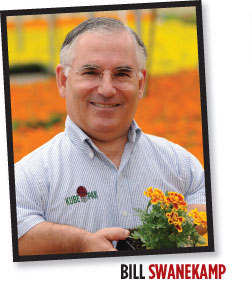2/26/2016
Thumbs Up or Down?
Bill Swanekamp

Many of us attend Cultivate each July in Ohio. This is the largest trade show for our industry and it’s well attended. Usually there’s a great deal of excitement in the air, as growers and nurserymen from around the country come to see what’s new and useful.
Interestingly, the most common question I’m asked each July is, “How was your spring?” We all like to talk about our successes and skirt over our failures. In July 2015, the mood in Ohio was very upbeat, as a large percentage of growers had great spring weather and strong sales.
Now the more difficult question to answer is this: What will spring of 2016 hold for us? As an eternal optimist, I’m hoping for another spring like 2015—more demand than supply, along with nice weather. Will that be the case for spring of 2016? I wish I had the answer to that question, but I don’t. What I do know is that our plug orders are up and our custom finished growing is also up. In addition, we’re already hearing from customers about some of our summer programs. These are all good signs that the confidence seen last year is still strong and might just translate into good sales this spring.
Is there anything we can do to ensure success this spring? There are three variables we can control and one we cannot:
The first is quality. The bar for quality plants has been raised over the past 20 years to levels that our parents could never attain. When I speak with people outside of our industry I tell them that the science of growing wasn’t fully understood until 25 years ago. They find that hard to believe. But we know that the slogan “he must have a green thumb” came about because often times one’s success at growing over another’s failure couldn’t be explained. Now we know the science; the only question is, do you? Yes, there’s a lot to learn, but once we learn the interaction between water, media and fertility, then success can be repeated.
The second variable is service. Our customers are demanding more and more from their suppliers each year. In the past, we delivered the plants and left. Now we have to deliver the plants, help unload the truck, put the flats on the display shelves or leave the carts, provide point-of-purchase signage, barcode each flat, and then pick up the empty carts. Many are asking for plants that are grown without neonicotinoids—another difficult challenge. Yet, if we can provide a consistent level of service, our customers will succeed and so will we.
The third variable is price. We all need to raise our prices. From 2008 until 2012, it was very difficult to raise prices and those who weren’t in a strong position financially found themselves floundering under a debt load they couldn’t maintain. That’s why, according to Charlie Hall, about 30% of growers went out of business over the past seven years. Some were large, but most were small. One way to improve the bottom line is to raise prices. Fed Ex and UPS raise their prices 4% to 5% every year. Can you get away with it? That depends on how well you communicate to your customers the need for regular increases that match higher production costs. If you don’t steadily raise prices, your business will slowly crumble like a house eaten up by
termites.
Finally, the fourth variable that we cannot control, is weather. Yes, weather. Who of us doesn’t offer a little prayer asking for favorable weather in the spring? This variable is beyond our control and prediction, so we have to have in place tools that allow us to “weather the storm.” If the spring is cold and late, we may have to use some growth regulators to keep the crops from getting too tall. It might also require more fungicidal sprays, but if we stay on top of this, we might just get out of the bad weather unscathed.
The other important tool is the capacity to ship spring material when the season is late. It might just be that there’s only a three-week window to ship the majority of the crop. Do you have the trucking capacity to do this? If you do, then it can mean the difference between success or failure.
So let’s go into the spring with high hopes and finish the spring with a broad smile.
GT
Bill Swanekamp is president of Kube-Pak Corp., Allentown, New Jersey.